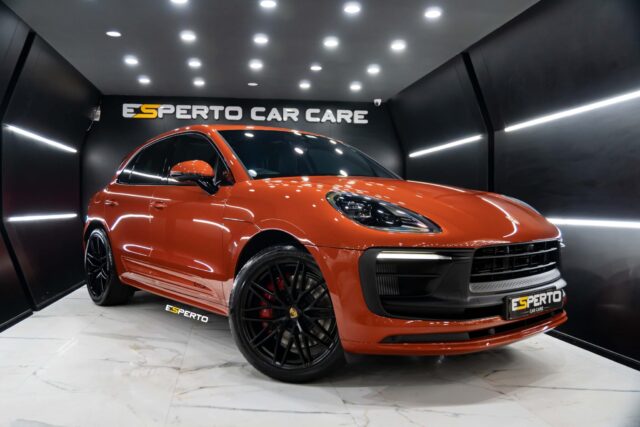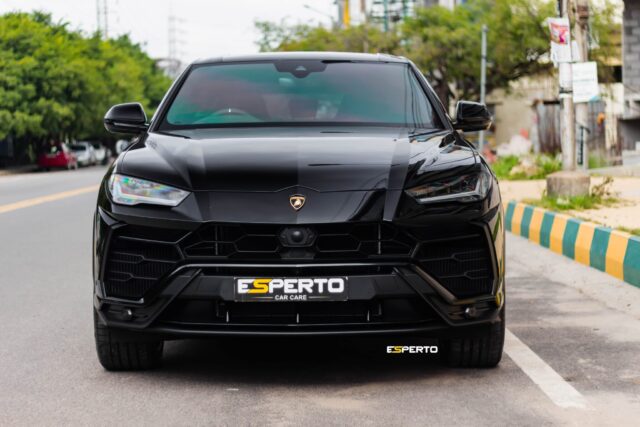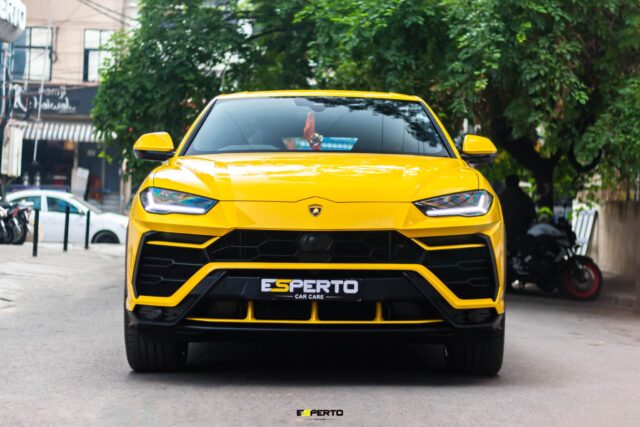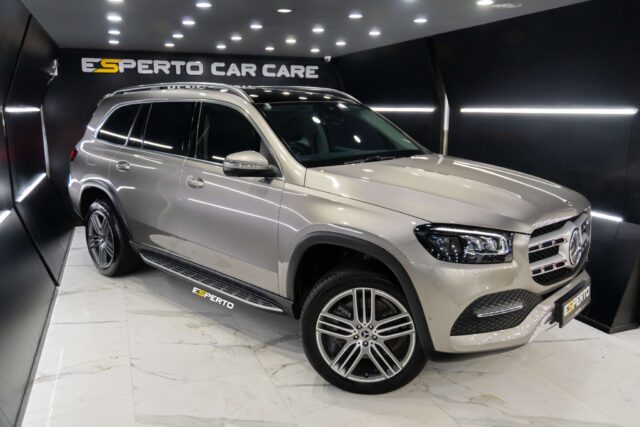Many car owners wonder how to know if their vehicle has a ceramic coating. This question pops up often because understanding the condition of your car’s paint protection can be tricky.
A ceramic coat offers a durable layer of protection for your car, keeping it safe from environmental factors and making cleaning easier. Knowing whether your vehicle has this protective coating is crucial for preserving its look and durability.
Ceramic coatings provide cars with incredible Glossy Finish with Ceramic Coating and hydrophobic properties, allowing water to bead up and roll off the surface effortlessly. In this article, we’ll share simple tips on how to know if your car has ceramic coating.
You’ll learn about visual signs, performing a water beading test, and consulting with professionals. Find out all you need to ensure your ride gets the best care possible.
Stay tuned!
What is a ceramic car coating, and How Does it Work?
A ceramic car coating is a liquid polymer that interacts with a vehicle’s paint, establishing a protective cover on its surface. This car ceramic coating product serves as a barrier against environmental contaminants like bird droppings, tree sap, and UV rays, ensuring the car retains its shiny presentation.
Applying a ceramic coating to your vehicle augments its aesthetics and boosts durability by safeguarding it from wear and tear.
ceramic car coatings bestow vehicles with enduring radiance and defense.
This sophisticated defense operates utilizing chemical bonding that doesn’t dissolve or degrade over time. Contrary to traditional wax, which requires constant reapplication, superior ceramic coatings can endure for years.
The procedure involves sanitizing the vehicle’s exterior rigorously prior to evenly applying the coating to the bodywork. Once set, it forms an invisible protection that displaces water, making it challenging for dirt and grime to adhere to your car’s surface.
This water-repelling characteristic is a principal method to ascertain if your vehicle has received a ceramic coating.
Understanding the properties of ceramic coating
Ceramic coating on a car acts like armor, protecting the paint from various types of damage. This transparent layer is rigid yet flexible, safeguarding the vehicle’s exterior from scratches, dirt, and water.
Given its chemical composition, it bonds tightly with the car’s clear coat. This bond creates a durable barrier that enhances the gloss and prevents contaminants and acid rain from harming the surface.
Its long-lasting nature makes ceramic-coated cars easier to clean and maintain their shiny look for years. The ceramic coating repels water, making raindrops bead up and roll right off instead of sticking to the surface.
This hydrophobic property also helps in reducing streaks and drying marks after washing your car. Owners appreciate fewer trips to car washes due to this self-cleaning effect.
How long-lasting is a ceramic coat?
A ceramic coat offers remarkable longevity, protecting your car’s paint for up to five years. This durability stems from its advanced chemical properties that bond with the vehicle’s clear coat.
Such a strong bond creates a protective layer against various environmental factors, including UV rays and bird droppings, which often harm a car’s appearance. Owners appreciate this because it means their vehicles maintain that glossy, well-protected look much longer without needing frequent reapplications.
Maintaining this coating is straightforward: regular washing can keep the car looking pristine. Unlike traditional car waxing that requires application every few months, ceramic coatings reduce the frequency of such tasks dramatically.
This makes ceramic coating creates an efficient way to protect and enhance the gloss and durability of your vehicle’s surface while saving time on maintenance.
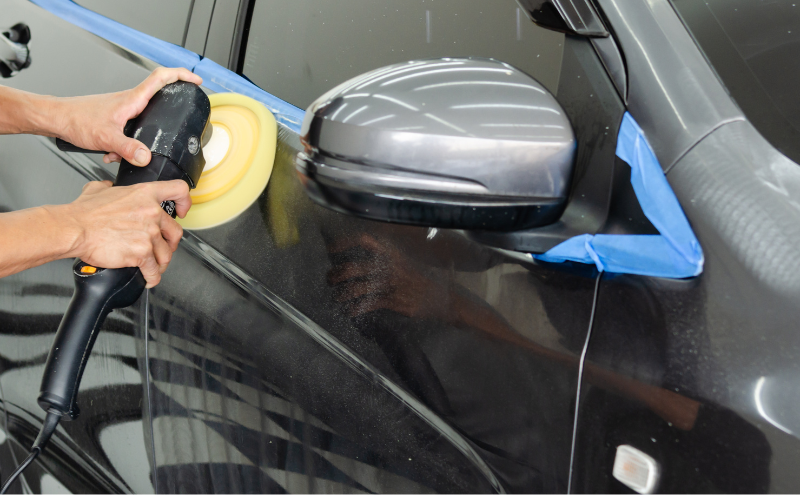
Why car owners choose ceramic coatings for paint protection
Auto owners often opt for ceramic coatings for paint protection due to their enduring and long-lasting characteristics. Ceramic coatings form a toughened layer over the auto’s distinct coat, providing heightened protection against environmental phenomena such as UV rays and bird excrement.
This advanced layer nano coating serves as a shield, sustaining the auto’s gleaming finish and simplifying the cleaning process.
“Ceramic coating maintains your auto’s novel appearance for a longer duration, eliminating the need for constant polishing.”
This security layer amplifies not just the aesthetic appeal of your vehicle but also aids in maintaining the vehicle’s worth by averting early fading and oxidization. By choosing a ceramic coating, auto enthusiasts can ensure their cars are guarded against diverse pollutants.
The water-resistant property of reputable ceramic coatings causes water to bead off effortlessly, reducing water marks and lessening upkeep labors.
How do I know if my car has been ceramic-coated
Checking if your car has a ceramic coating involves observing specific signs and conducting simple tests. Look for a slick, glossy surface that repels water easily. This indicates the presence of a quality ceramic coating.
Ceramic coatings give cars that distinct shine while offering protection against environmental damage.
To further confirm, perform a water beading test on the surface of your vehicle. Spray some water on your car; if it forms tight beads and slides off quickly, your car likely has ceramic protection.
Cars with ceramic coatings showcase hydrophobic properties, making water droplets bead up and roll off effortlessly. You can also seek confirmation from a professional installer who can tell by examining the paint’s condition whether your car is ceramic coated or not.
Visual signs that your car has a ceramic coating
Ceramic coatings give your car a unique gloss and protection. This makes telling if your car has a ceramic coating vital for maintaining its appearance and durability.
- High Gloss Finish: Cars with ceramic coatings display a deep, glossy finish that regular paint jobs can’t match. This enhanced shine is due to the properties of the ceramic coating that reflect light more effectively.
- Water Beading: One of the clearest visual signs is water beading on the surface of the vehicle. Ceramic coatings create a hydrophobic layer, causing water to form tight beads and roll off easily.
- Smooth Texture: Running your hand over the paintwork can reveal a lot about its condition. A ceramic-coated car feels exceptionally smooth, free of contaminants that typically stick to the clear coat.
- Enhanced Color Vibrancy: Ceramic coatings enhance the color depth of your vehicle’s paint. Colors appear more affluent and more vibrant, making this another handy tip-off.
- Resistance to Swirl Marks: While not entirely immune, cars with quality ceramic coatings show fewer swirl marks or fine scratches. The protective layer absorbs impacts that would otherwise damage the car’s clear coat directly.
- Dust Repellence: Cars treated with ceramic coating tend to repel dust better than untreated ones due to their anti-static properties. If you notice less dust on your car compared to others, it might have a ceramic layer.
- Durability Over Time: Regular wax jobs lose their luster within weeks, but a ceramic-coated car maintains its glossy appearance for months or even years without reapplication needed.
Identifying these signs helps owners understand whether a new coating protects their vehicles or if they should consider applying a ceramic coating for lasting beauty and protection.
Performing a water beading test to check for hydrophobic properties
After examining visual signs, the water beading test serves as a reliable method to tell if your car has ceramic coating. This test reveals the hydrophobic properties that are typical of a ceramic-coated surface.
- Find a small area on your car to perform the test.
- Pour a small amount of water onto this area.
- Observe how the water behaves.
- If the water forms tight beads and rolls off quickly, this indicates a ceramic coating is present.
- A surface without ceramic coating will show water spreading out flat and lingering longer.
- Repeat the test in different sections to confirm consistency across your vehicle.
- Note variations in beading as potential signs of wear or improper application.
- Contact a professional installer for further analysis if results are inconsistent.
This simple yet effective method helps car owners make an informed decision about their vehicle’s paint protection status and take necessary actions for maintenance or reapplication.
Consulting with a professional installer for confirmation
Checking with a professional installer is a surefire way to confirm if your car has a ceramic coating. These experts use tools and techniques that can accurately determine the presence of a ceramic layer on your vehicle.
They know to assess not just whether your car has been coated but also if the job was done correctly.
Professional installers can offer expert guidance on how to maintain the best ceramic coating ever, ensuring it provides long-lasting protection and appearance enhancement for your car. Consulting them helps you get the most out of your investment in automotive aesthetics and paint protection film (PPF).
For routine maintenance, it’s also recommended to use a clean microfiber towel when wiping down your vehicle. This prevents scratches and helps preserve the ceramic coating’s effectiveness.
How does ceramic coating differ from paint protection film (PPF)?
Weighing the options between ceramic coating and paint protection film (PPF) for your vehicle involves understanding their differences and benefits. Each offers unique advantages for protecting your car’s exterior and maintaining its aesthetic appeal.
Feature Ceramic Coating Paint Protection Film (PPF)
Protection Level High-grade chemical resistance against contaminants and minor scratches Superior physical barrier against scratches, rock chips, and more
Durability Lasts 2-5 years, depending on maintenance and environmental factors. Can last up to 10 years with proper care
Appearance Enhances gloss and paint depth Preserves original paint appearance and can be gloss or matte
Self-healing Properties Do not have self-healing properties. Minor scratches can heal with heat exposure
Cost Generally more affordable than PPF More expensive due to its advanced protection features
Maintenance Requires regular washing and occasional reapplication for best results. Low maintenance but may require frequent washing and professional inspection for any damages
Application Areas Can be applied to the entire vehicle or specific parts. Typically applied to high-impact areas but can cover the whole vehicle
Choosing between ceramic coating and PPF depends on your specific needs for durability, appearance, and level of protection. Car owners and enthusiasts who prioritize a glossy finish with excellent contaminant resistance might favor ceramic coatings. Those prioritizing the highest level of physical protection might select PPF, especially in areas prone to rock chips and scratches. Making an informed decision for your vehicle’s requirements comes from understanding these key differences.
Critical differences between ceramic coatings and PPF
Understanding the critical distinctions between ceramic coatings and Paint Protection Film (PPF) is crucial for car owners, enthusiasts, and bike lovers who are passionate about maintaining their vehicle’s appearance and protecting it from environmental hazards. Both options offer valuable benefits, but they serve different protective purposes and come with unique features. Below is a comprehensive comparison to assist you in making an informed choice about which protection method best suits your vehicle’s needs.
| Feature | Ceramic Coating | Paint Protection Film (PPF) |
|---|---|---|
| Composition | Made of silicon dioxide or other polymer compounds that bond with the paint | Thick, thermoplastic urethane film |
| Protection Offered | Protects against UV rays, light scratches, and chemical stains and provides a hydrophobic surface | Guards against rock chips and deep scratches and can self-heal minor scratches under heat |
| Appearance | Adds a glossy finish and enhances the paint’s depth and clarity | Preserves original paint look but may add a slightly different texture |
| Application | Applied as a liquid and cures to form a solid layer | Applied as a pre-cut or custom-cut film |
| Longevity | Can last 2-5 years, depending on maintenance and environmental conditions | Typically lasts 5-10 years, varying by product quality and maintenance |
| Maintenance | Requires regular washing and occasional reapplication of top coat for best performance | Needs washing and can be waxed; less frequent maintenance compared to ceramic coatings |
| Cost | Generally less expensive upfront but may require more frequent reapplications | It is more costly initially but offers longer-lasting protection without the need for reapplication. |
This comparison highlights the fundamental differences between ceramic coatings and PPF. When choosing between these two, consider your vehicle’s specific needs, how you use your car, and the level of maintenance you’re willing to perform. Both options provide substantial protective benefits that contribute to maintaining your vehicle’s aesthetic and resale value over time.
Benefits of using both ceramic coating and PPF
Exploring the distinctions between ceramic coatings and PPF is crucial to appreciate their combined advantageous effects. Employing ceramic coating in tandem with paint protection film (PPF) for your automobile offers a comprehensive defense layer, amplifying the overall defense against environmental dangers and wear.
With its lustrous sheen, the ceramic coating provides resistance against chemical stains and damage from bird droppings or UV rays. This durable sealant helps car enthusiasts maintain their car’s pristine look while simplifying cleaning.
Conversely, PPF offers shield-enhanced protection against physical damage like rock chips, scratches, and so forth. The fusion of these two protective measures offers automobile owners well-rounded protection.
Ceramic coatings exhibit water and dirt repelling qualities, and PPF acts as a safeguard against impacts that could directly damage the paintwork.
Utilizing both a ceramic coat and PPF enhances your vehicle’s exterior appeal while providing reinforced defense mechanisms.
Can environmental factors affect the presence of a ceramic coating?
Environmental factors have a significant impact on the lifespan and effectiveness of a ceramic coating on your car. UV rays from the sun can gradually wear down the coating, affecting its ability to protect the vehicle’s paint from fading and damage.
Similarly, bird droppings are acidic and can etch into the surface if not cleaned promptly, potentially compromising the integrity of the ceramic coating. Regular maintenance is crucial to ensuring that these environmental challenges do not diminish the protection and aesthetics that a ceramic coating provides for your car.
To maintain the glossy finish and durability of your car’s clear coat, it’s essential to follow best practices for care. Washing your vehicle regularly helps remove contaminants like dirt and pollutants that might stick to the surface more quickly due to environmental exposure.
Ensuring that you reapply a new ceramic coating at recommended intervals also preserves its hydrophobic properties, which contribute significantly to reducing frequency of washes needed by repelling water effectively.
This proactive approach to vehicle protection ensures lasting protection against various environmental impacts, keeping your car looking great over time.
Impact of UV rays and bird droppings on ceramic-coated cars
UV rays and bird droppings can challenge the durability of a ceramic coating on cars. Exposure to UV rays over time may lead to degradation, affecting the gloss and defense of the ceramic layer.
This can make your car’s finish look less vibrant and reduce its protective qualities. On the other hand, bird droppings contain acids that can etch into the ceramic coat if not cleaned promptly.
The acidic nature starts to erode the surface, potentially leading to permanent marks or damage if left unattended.
To ensure your vehicle maintains its appearance and protection against environmental elements, it’s crucial to regularly clean off bird droppings and consider applying a top-up coat every few years. This maintenance helps in preserving both the gloss and durability of your car’s ceramic coating against such environmental factors.
Proactive care keeps your car looking great while extending the life of its ceramic protection from UV rays and environmental contaminants like bird waste.
How to maintain the gloss and durability of your ceramic coating
Maintaining the gloss and durability of your car’s ceramic coating ensures your vehicle remains in top condition. Proper care will make it look stunning for years to come.
- Wash your car regularly using a pH-neutral shampoo designed explicitly for ceramic-coated vehicles. This prevents dirt build-up without harming the coating.
- Avoid washing your car in direct sunlight to avoid water spots that can damage the coating’s appearance.
- Use a gentle microfiber towel to dry the surface to reduce the risk of scratches on the ceramic surface.
- Apply a ceramic boost product every few months to reinforce the hydrophobic properties of your existing ceramic coating.
- Keep your car away from abrasive chemicals that can strip away the coating, such as strong detergents or acidic substances.
- Schedule professional inspections annually or bi-annually to check if reapplication is necessary for maintaining the desired level of protection.
- Protect your car from prolonged exposure to UV rays by parking in shaded areas or using a car cover, since intense sun can degrade the coating over time.
Next, let’s explore the ways to tell if a car has been appropriately coated.
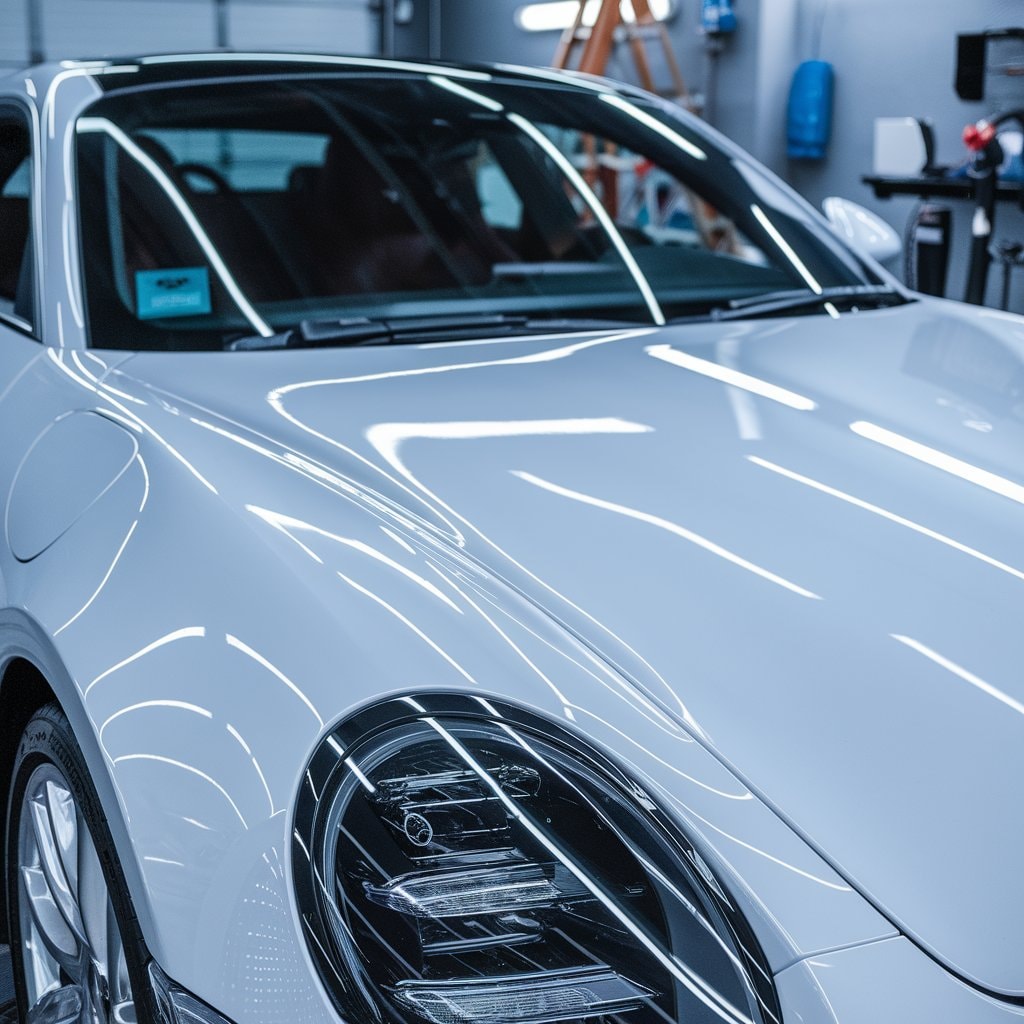
What are the ways to tell if a car has been appropriately coated?
You can tell if your car has a proper ceramic coating through a few clear signs. A quality ceramic coating leaves the vehicle with a shiny finish, improving the look of your car significantly.
If the surface feels exceptionally smooth and water forms tight beads that roll off quickly, it shows hydrophobic properties are in effect, indicating a good application.
Professionals ensure an even coat across all areas, so uneven texture or missed spots suggest an improper job. Look for evidence of thorough coverage by inspecting edges and hard-to-reach spots that dealerships sometimes overlook.
If you find any part of your car lacking in shine or water resistance compared to others, it might need reapplication or correction by someone experienced in apply ceramic coatings to cars.
Signs of quality ceramic coatings
Identifying a quality ceramic coating on your vehicle is crucial for ensuring long-term protection and shine. High-standard ceramic coatings offer exceptional benefits that go beyond ordinary car care practices.
- The surface feels smooth to the touch: A vehicle with a high-quality ceramic coating will have an exceptionally smooth surface, reducing drag and improving aerodynamics.
- Enhanced gloss and color depth: Cars with superior ceramic coatings display a significant enhancement in gloss and the richness of the paint’s color, making them stand out.
- Superior hydrophobic properties: Water beads up and slides off easily, indicating the coating’s effectiveness at repelling water.
- Resistance to chemical stains: Quality coatings protect against corrosive contaminants such as bird droppings and tree sap, preventing etching or staining.
- UV protection: Ceramic coatings shield the paint from harmful UV rays, reducing oxidation and fading over time.
- Durability lasts for years: A hallmark of high-end ceramic coatings is their longevity, often lasting several years before needing reapplication.
- Ease of cleaning: Dirt and grime rinse off more effortlessly compared to vehicles without such protection, cutting down cleaning time significantly.
- Scratch resistance is improved: While no coating can make a car completely scratch-proof, top-tier ceramics enhance resistance to minor scratches and swirl marks.
- Professional application evidence: Look for signs of professional installation, such as even coverage without patchiness or streaks, indicating expertise in the application.
Each of these features contributes to maintaining your car’s appearance while also protecting its value over time. Investing in a quality ceramic coating installed by experienced professionals can yield substantial benefits for any vehicle, enhancing its beauty and defending it against environmental factors.
Indicators of improper application and reapplication
Applying a ceramic coating to your car demands careful attention and expertise. Signs of improper application and reapplication can impact the durability and appearance of your vehicle.
- Streaks or smears on the paint surface. These occur when the coating isn’t evenly distributed.
- Visible swirl marks or scratches. They hint that the surface wasn’t properly prepared before applying the ceramic coating.
- Hazy or cloudy areas suggest that the coating was not correctly cured.
- Inconsistent hydrophobic properties across different sections of the vehicle indicate uneven application.
- Peeling or flaking of the coating points to poor adhesion, often due to inadequate surface prep.
- Reduced gloss or shine in certain areas may signal an uneven layer of ceramic coating was applied.
- Spots that attract dust or dirt more than others show where the coat might be too thin or missed entirely.
- Difficulty in cleaning, as a well-applied ceramic coat should make washing off contaminants easier.
These signs help tell if my car doesn’t have an adequately applied ceramic coating, emphasizing the importance of choosing an experienced installer for this task.
Importance of choosing an experienced installer
Choosing a skilled professional to apply ceramic coating to your vehicle ensures the task is done correctly. Such specialists possess the required expertise to apply the coating uniformly, circumventing issues like uneven application or missed areas.
They understand the longevity of a ceramic coat and promise its durability. A properly applied ceramic coating safeguards a vehicle’s paint for numerous years, minimizes the need for frequent waxing, and perpetuates the luster.
Skilled professionals can also discern if a car already possesses a coating and provide advice on appropriate care. They facilitate periodic reapplications if needed, thereby solidifying comprehensive protection for your vehicle from environmental impacts.
To summarize, choosing a well-versed professional not only ensures quality but also prolongs the lifespan of your car’s visual attractiveness.
Conclusion
After exploring the crucial role of an experienced installer in achieving optimal results with ceramic coatings, it’s clear that having a vehicle ceramic coated provides not just superior protection but also enhances its overall aesthetic appeal.
The process requires precision and understanding to ensure that the coating on the car effectively guards against environmental factors while maintaining its gloss and durability over time.
Quality is never an accident; it’s always the result of intelligent effort.
Determining whether your car has a ceramic coating involves looking for visual signs, conducting water-beading tests for hydrophobic properties, or consulting with professional installers.
These steps are essential in confirming that your vehicle benefits from this advanced level of protection. For those comparing different forms of paint protection, like ceramic coatings and PPF, each offers unique advantages.
Combining them could provide your car with ultimate defense against wear and contaminants. Finally, regular maintenance after ensuring proper application helps sustain the protective qualities and visual appeal of your car’s coat, which further reduces the frequency of needed reapplications or touch-ups.


